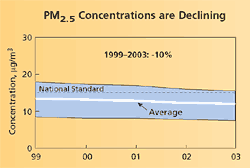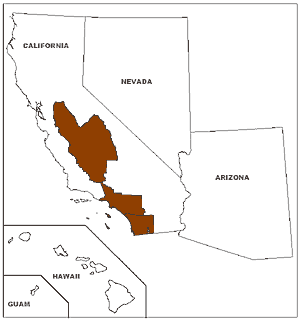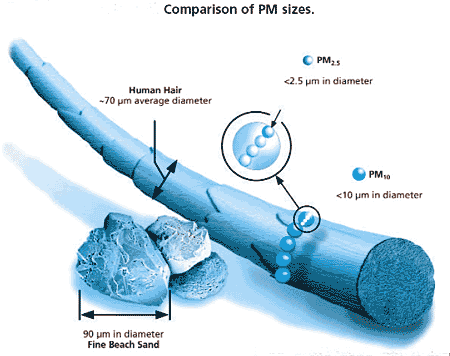Contact EPA Pacific Southwest Air Program
Pacific Southwest, Region 9
Serving: Arizona, California, Hawaii, Nevada, Pacific Islands, Tribal Nations
Featured Story: Areas Designated for Fine Particulate Standards

National Links
Regional Links
The nation's first-ever fine particle standard portends large ramifications in the Pacific Southwest. Three areas in California -- San Joaquin Valley, South Coast and San Diego -- fail to meet the new standards, while all parts of Nevada, Arizona, Hawaii and the Pacific Islands are in attainment.
The EPA informed states and tribes of the status of counties in late December 2004 as the country prepares to meet the nation’s first fine particle (PM2.5) air quality standard. These tiny particles - approximately 1/30th the size of a human hair - have been scientifically linked to serious human health problems including premature death from heart and lung disease; aggravation of heart and lung diseases; chronic bronchitis and asthma; increased hospital admissions and doctor and emergency room visits; and absences from work and school.

Nationwide, meeting these standards will prevent at least: 15,000 premature deaths; 75,000 cases of chronic bronchitis; 10,000 hospital admissions for respiratory and cardiovascular disease; hundreds of thousands of occurrences of aggravated asthma; and 3.1 million days when people miss work because they are suffering from symptoms related to particle pollution exposure.
"Fine-particle pollution represents one of the most significant barriers to clean air facing our nation today," Leavitt said. "these new particulate health standards, coupled with our efforts to reduce power plant and diesel emissions, are important steps toward meeting our nation's commitment to clean, healthy air."
The term "particulate matter" includes both solid particles and liquid droplets found in the air. Many anthropogenic and natural sources emit PM directly or emit other pollutants that react in the atmosphere to form particulate matter. Fine particles can be emitted directly (such as the smoke from a fire), or they can form from chemical reactions in the air. Those chemicals come from a variety of sources, including cars, trucks, buses, construction equipment, industrial facilities and power plants. The major constituents of PM2.5 are sulfates, nitrates, and carbon compounds.

EPA's action plays an important role in informing the public about the air quality in the areas where they live, work and play. For more detailed maps of these areas, please visit Particulate Matter (PM-2.5) Attainment Designations in the Pacific Southwest. To develop these final designations, the EPA requested recommendations from state governors and tribal leaders on the appropriate boundaries for nonattainment areas. The EPA carefully reviewed the state and tribal recommendations and revised them in June 2004 - adding more than 100 counties that the EPA believed contributed to air quality violations. The agency then provided the opportunity for state and tribal representatives to respond. The EPA’s recommendations included counties where monitors show violations of the PM2.5 standards and surrounding counties that contribute to those violations.
More Information
The reduction of fine particle pollution is a critical element of the agency’s comprehensive national clean air strategy. This strategy includes EPA's recent rule to reduce pollution from nonroad diesel engines, and the proposed rule to reduce pollution from power plants in the eastern U.S. These two rules are important components of EPA's efforts to help states and localities meet the more protective national fine-particle and 8-hour ozone air quality standards. Together these rules will help all areas of the country achieve cleaner air.
What’s Next
States with nonattainment areas must submit plans by early 2008 that outline how they will meet the PM2.5 standards. They are expected to attain clean air as soon as possible an not later than 2010. The EPA can grant one five-year extension for areas with more severe problems. The attainment date for those areas would be 2015.
